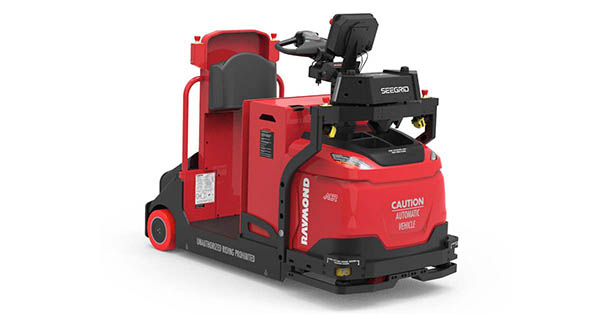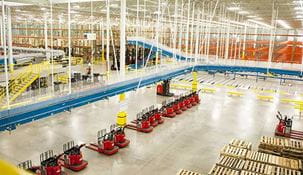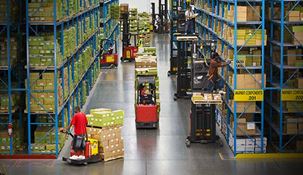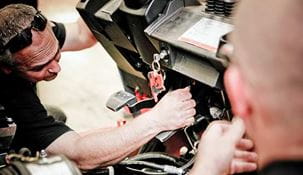-

Greensboro Autonomous Guided Vehicle (AGV)
Carolina Handling sells, installs and maintains Autonomous Guided Vehicles (AGVs) and other AS/RS equipment in North Carolina and across the Southeast. Our automation specialists can help you find the perfect solution from world class AS/RS manufacturers like Modula.
North Carolina Autonomous Guided Vehicle Supplier
What is an AGV?
Often described as automatic guided vehicles or self-guided vehicles, automated guided vehicles (AGVs) are material handling systems or load carriers that move autonomously across the ground surfaces of a warehouse, factory or DC without an onboard driver.
What are Automated Guided Vehicles used for?
Common AGV applications include storage and retrieval in storage facilities and distribution centers, usually in support of order picking. They are similarly used for transport of raw materials, work-in-process and finished products in factories.
What are some of the main advantages of Self-Guided Vehicles?
- Decreased Labor Costs: AGVs can substantially minimize labor expenses. A one-time expenditure can get rid of the ongoing expenses of salaries, taxes and benefits connected with a full-time employee.
- Increased Safety: Modern AGVs use sophisticated cameras, lasers or other sensors that allow them to "see" and react to their environment very quickly. Humans can get tired or distracted, whereas machines do not. AGVs can also be used in extreme conditions or around hazardous materials where human security is jeopardized.
- Increased Productivity & Accuracy: AGVs can work continuously, never needing breaks or tiring. They can make distant treks across a large building effortlessly. They likewise don't make the kinds of errors that humans are prone to making.
- Modularity: Most AGV systems can be introduced gradually, replacing a handful of workers here and there without a massive capital outlay up front. As automation needs accelerate, more AGVs can quickly be added to the operation.
How do AGVs work?
AGVs are routed by a mix of sensor-based guidance systems and software. They can maneuver securely through a warehouse or manufacturing facility by using barrier detection bumpers and following thoroughly defined paths while using precisely managed acceleration and deceleration.
AGV navigation is generally managed by one of these types of systems:
- Vision guidance: Cameras record the AGV's surroundings, and the vehicles use these logged images to plot a course. Vision guidance is standalone, and as a result, no modification is required to a production facility or warehouse infrastructure for this kind of navigation.
- Laser target navigation: With laser solutions, reflective tape is affixed to pallet racks, wall surfaces, posts and other stationary items. AGVs use laser transmitters to rebound laser beams off of these reflectors and then utilize the proximity and angle of items to navigate.
- LiDAR: LiDAR systems transmit laser pulses to determine the space around the AGV and articles in its surroundings. This data is used to establish a 360-degree map of the environment. In similarity to vision guidance, no adjustment of a building is needed.
- Inertial navigation: Transponders embedded into a facility’s floor surface route AGVs along a specified track.
- Wired navigation: These systems employ wire pathways embedded into a warehouse or factory floor. The wire broadcasts a signal that an AGV detects via a sensor or antenna system.
- Magnetic guide tape: This style of AGV employs magnetic sensing units and conforms to a route laid out by magnetic tape.
What are the various kinds of Autonomous Guided Vehicles?
There are numerous kinds of automated guided vehicles. Many AGVs are similar to other human-operated vehicles but are engineered to maneuver with no direct human intervention or guidance.
- Forklift AGVs: Forklift automated guided vehicles are an often-utilized kind of AGV in warehouses. They're built to transport pallets without the supervision of a human driver.
- Automated Guided Carts: An automatic guided cart is probably the most rudimentary type of AGV. They can transport all kinds of products from entire pallets to small components. AGCs are frequently utilized in stocking, picking and cross-docking applications.
- Tugger AGVs: Towing or "tugger" AGVs tug non-powered, payload-carrying carts behind them in a train-like setup. These kinds of automatic guided vehicles are typically utilized for transporting heavy loads over long distances. Often times they are configured to make several drop-offs and pickups along their path.
- Unit Load Handlers: unit load handlers ferry singular loads like specific items or a discrete pallet or tote.
- Heavy Burden Carriers: These are utilized for exceedingly heavy payloads like coils, plates or castings.
Automated Guided Vehicle Supplier Near Me
If you'd like a full analysis of AGV options for your warehouse, DC or manufacturing facility, you can talk to an expert at Carolina Handling.
-
-
Proudly serving
Greensboro,
High Point, Kernersville,
Winston-Salem,
Clemmons, Burlington,
Salisbury, Rural Hall,
Thomasville,
and the entire
State of North Carolina.
You May Also Like:

Automation
Carolina Handling can help you automate every aspect of your warehouse operation to increase efficiency.
Learn More

Optimization
Optimize everything in your warehouse to improve productivity and reduce operating costs.
Learn More

Warehouse Products
Looking for the right product for your operation? We have everything you need to do business in stock.
Learn More

Service Maintenance
Providing superior lift truck service and maintenance for our customers is Carolina Handling's highest priority.
Learn More


